
YOU’RE a prospective medium-SUV buyer, lost, alone and confused in the woods, surrounded by a thicket of lookalike crossover choices. What do you do?
Happily, we’re here to help, having already sorted through the good, the bad and the ugly to arrive at the cream of the crop as rivals for Subaru’s new, fifth-gen Forester, with not a dull or dreary drive in sight.
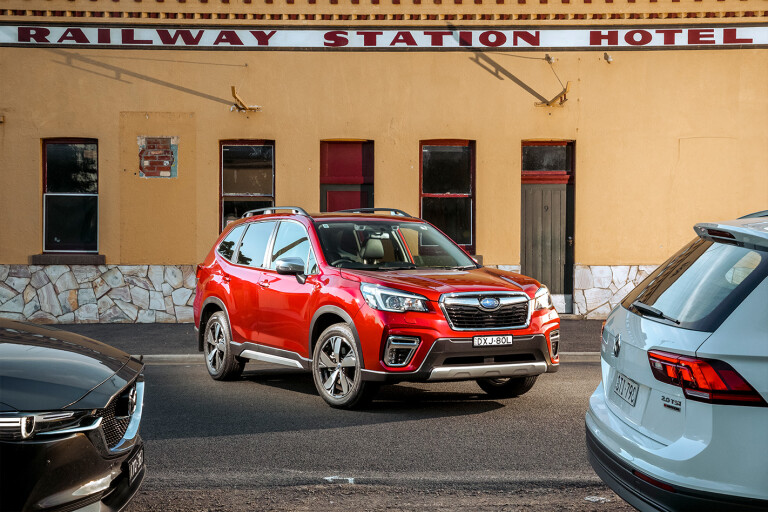
The evergreen Subaru Forester has been rooted in the medium-SUV scene since 1997, becoming a byword for sensible, practical and versatile lifestyle/adventure family car, with enough individuality to appeal to enthusiasts.
For her 21st this year, the Japanese carmaker gave the old girl a whopping makeover. Cosmetically almost identical, disappointingly, all the big coming-of-age advances occur under the fussy clothes, with the adoption of the latest Impreza’s imaginatively dubbed ‘Subaru Global Platform’ – the company’s first new global platform since the original Liberty’s launch in 1989.
Furthermore, a 90 percent new, 136kW, 239Nm 2.5-litre four-pot horizontally opposed powertrain debuts, along with an overhauled CVT auto, suspension (struts up front and double A-arms out back) and steering (electric, naturally), while annual servicing replaces the previous six-monthly workshop visits. A big improvement – at last.
Sub-$45,000 all-wheel-drive spec is where all the SUV action is, so we’re kicking off with the range-topping (for now) $41,490 Forester 2.5i-S – S standing for swanky, presumably, because it costs some $1750 more than the equivalent previous-gen variant.
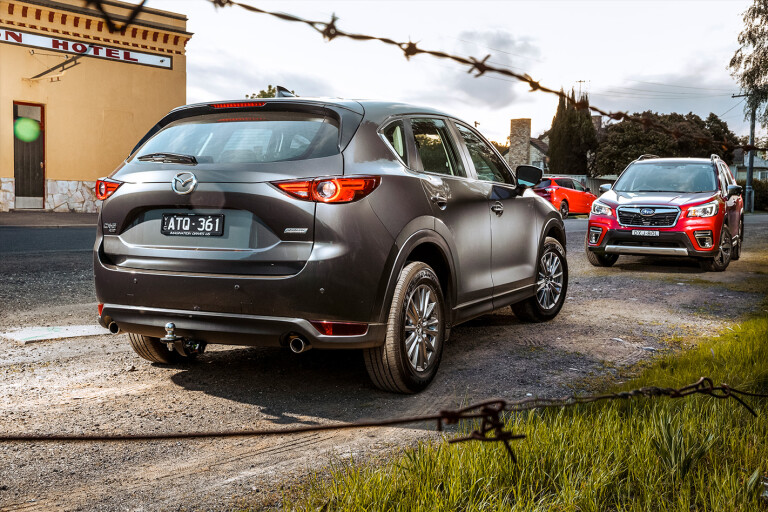
Oh, but we’re talking kitchen-sink chockers, with Subaru’s EyeSight dual-camera active safety gadgetry bringing front and rear autonomous emergency braking, rear cross-traffic alert, adaptive cruise control, lane-keep assist, blind-spot monitoring, adaptive LED headlights with auto high-beam, 360-degree-view cameras, drowsiness alert with facial recognition that recognises and memorises individual driving-position settings (creepy), powered front seat adjustment and rear backrests, a powered tailgate, climate control, keyless entry and start, an 8.0-inch touchscreen with sat-nav, DAB+ digital radio, Bluetooth, Apple CarPlay and Android Auto, ritzier trim, roof rails, 18-inch alloys, leather, a sunroof and high-end audio. But no heated seats, oddly.
Choosing the 2.5i Premium sees you forgo those last three items, saving $3K and taking the Forester to $38,490, which is exactly how much Mazda charges for its sporty and stylish CX-5 in Touring AWD guise, now powered by a 140kW, 252Nm 2.5-litre atmo four. Now? Launched in early 2017, the second-gen KF really stepped up refinement wise, and was followed a year later by a Series II update with cylinder de-activation for better economy, among other updates that brought slightly higher outputs.
However, for the CX-5 to match the Forester’s cabin luxury, you’ll need the $43,590 GT we requested for this test, or the $46,190 Akera for almost equivalent safety, just without the Subie-exclusive drowsiness monitor and face-recognition tech. Note, though, that Touring strikes back with a handy Traffic Sign Recognition and head-up display.
Volkswagen, too, has offered a medium-SUV class ace since the latest (Mk2) Tiguan surfaced in September 2016. Essentially a jumped-up version of our COTY-winning Mk7 Golf, refinement, functionality, efficiency and sophistication are this Teuton’s calling cards.
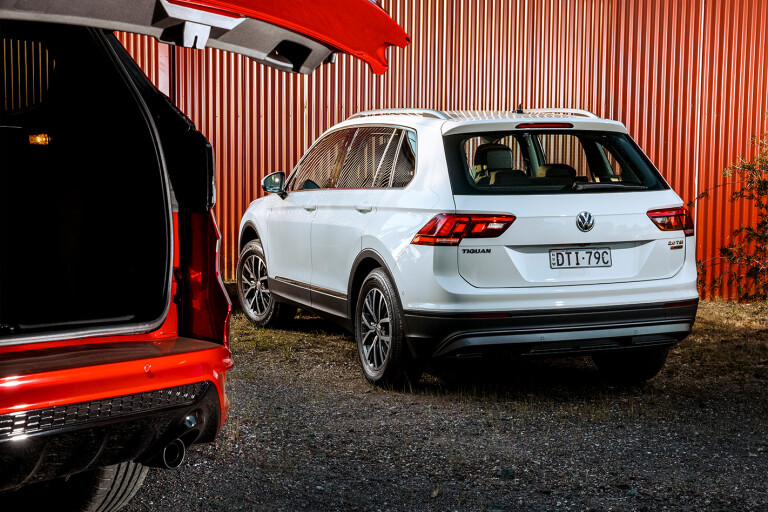
For MY19, the $42,490 Comfortline 4Motion DSG, powered by a 132kW, 320Nm 2.0-litre turbo-petrol engine, scores extra kit over the cheaper 2018 model tested, including keyless entry and start, a powered tailgate and 18-inch alloys – so we’ve factored these into our assessment. To match the Subaru’s bounty, though, please tick the $4000 Luxury and $1400 Driver Assistance packs, taking that to nearly $48K. Autsch! Conversely, the VW is alone with its sliding rear seatbase, hidden drawers, overhead storage, back-seat trays and preposterous name: Tiguan is an amalgam of tiger and iguana.
Finally, speaking of humour, a wildcard. The Spanish-built Ford Escape (or Kuga as this Mk2 version was called from its mid-2013 arrival until the extensive MY17 facelift) always finished at the pointy end of previous encounters, impressing with engaging dynamics, hearty performance and real chassis nous.
Now, there’s the newly hatched $39,990 Escape ST-Line. Derived from the 178kW, 345Nm 2.0-litre turbo Trend, it dons the automotive equivalent of a track suit and trainers in the form of a body kit, 19-inch alloys, quicker steering, 10mm-lower ride height, thicker anti-roll bars, racier seats and moodier trim… though for Forester-equalling safety please pay another $800. Like Mazda, Ford has adopted a five-year warranty, which is an extra-cost option on the other two.
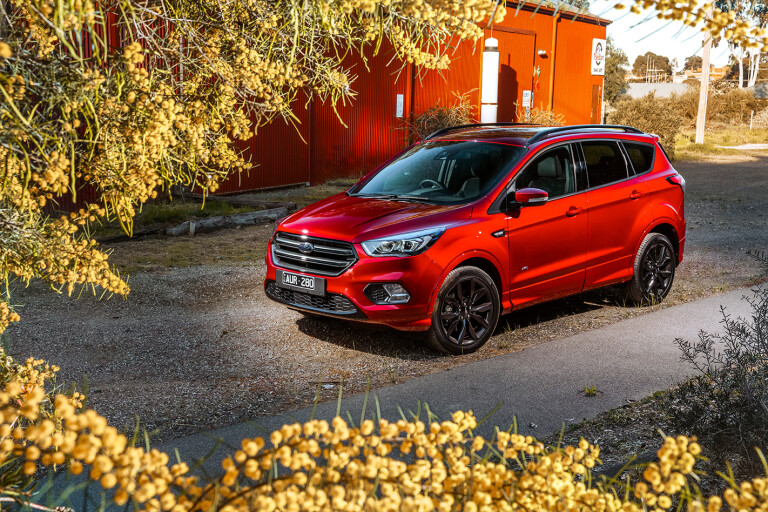
From a packaging point of view, all four offer compelling virtues such as excellent entry and egress, lots of room and a decent cargo area, but only one of them truly nails the brief.
Over five generations, the Forester’s cabin has gently evolved around owners’ need for space, clarity, storage, personal comfort and ease, while paying lip-service to fashion, and it’s now at a point where there’s precious little to fault. The tall ceiling, deep glasshouse, narrow pillars, low dash and lofty, sumptuous seating collude to make the Subaru seem cavernous, airy and inviting. Attention to detail is pleasing too – though the barrage of data screens can be intimidating, and a squeak from the driver’s door soon became infuriating.

Likewise, the Tiguan stands out with its slick, premium sheen, techy ambience, classy instrumentation, tactile surfaces, rich aromas and smart use of space. Firm but supportive seating, the versatility of that sliding back seat, lots of glass and a multitude of small but pleasing surprise-and-delight features such as the touchscreen user interface nourish something emotional like no other can.
But are these enough when considering how much higher the price of Comfortline entry is, and how much shorter the standard kit list is? Plus, while hushed and creamy-smooth on the move, bumps and coarser bitumen expose an underlying, erm… stiffness underneath. And this is only on 17s, not 18s.
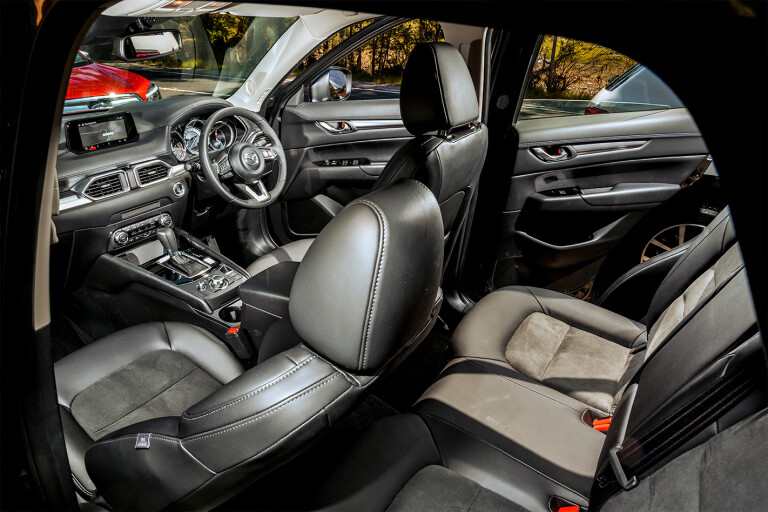
The cosy, yet by no means cramped CX-5 feels altogether more intimate, largely because of the smaller glasshouse and unexpectedly opulent materials, offering a superb driving position, a beautifully integrated dashboard with lovely white instrument markings, consistent trim choices, precision controls, faultless ergonomics, supportive front seating and a deluxe back seat environment. In fact, our Touring seems richer than the exxier Tiguan.
On the flipside, the Mazda’s touchscreen looks passe and lacks CarPlay and Android Auto, and there’s still noticeable engine and road-noise intrusion back there.
Nobody expected the Escape’s ageing interior to win friends and, for sure, in this company the fussy, imposing dashboard looks a little cheap in places, the extra-thick A-pillar bases can hide whole cityscapes, and thin rear cushions could use more padding.
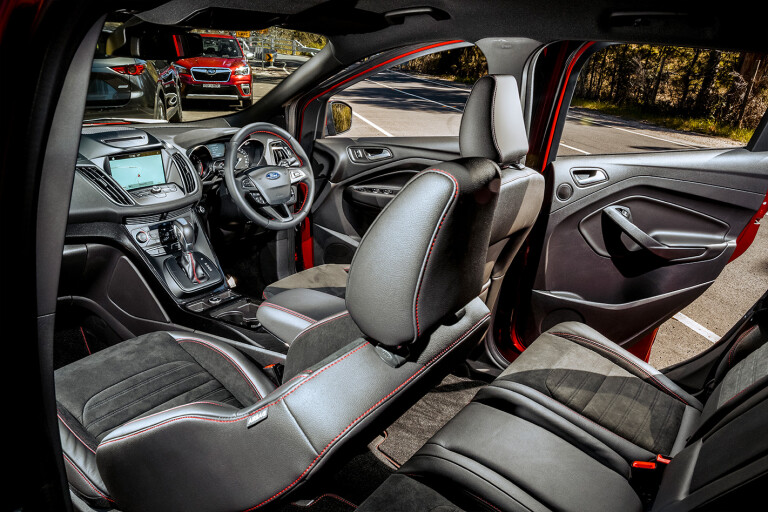
Yet, even on 19s and with lowered suspension, the ST-Line’s ride tune hasn’t relinquished Ford’s renown underlying suppleness, and it’s pretty quiet too. Better yet, being the most overtly sporty, the Blue Oval soars even further from the moment the starter is pressed.
If not the hot-hatch, the tepid-tailgate of the foursome, with greater power and torque on tap, the fiery Euro with a regular-Joe six-speed torque-converter auto lives up to its name by literally escaping from the non-turbo twosome. It’ll eventually pulling clear from the Tiguan too; 7.7 seconds to 100 clicks and 15.6sec across 400 metres are impactful – literally so, since an 11.3L/100km average also makes the heavyweight ST-Line the group’s dipsomaniac by some margin.
While not quite the lightest, the Vee Dub, as the second-sprightliest overall, delivers a lesson in efficiency, because it’s only a couple of tenths short of the hard-charging, hard-drinking Ford – and only half a second behind by 140km/h – yet is a whopping 20 percent more economical. Especially impressive considering the mere 346km on the odo.
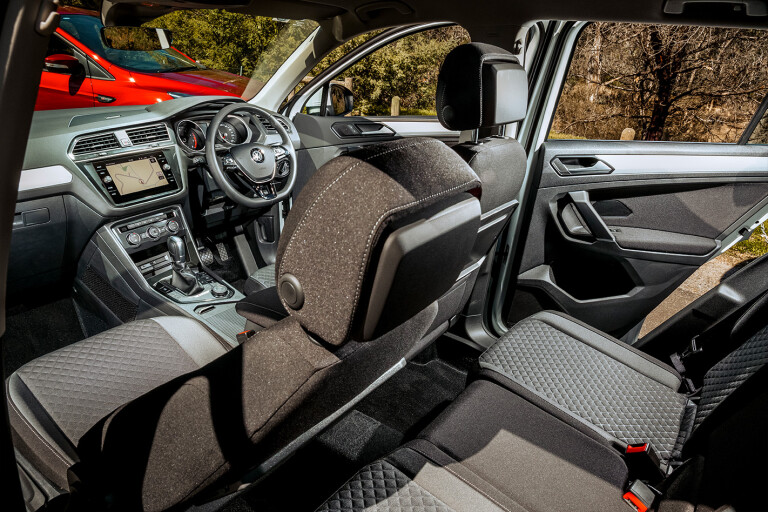
Kudos, then, to the velvety EA888 turbo and seven-speed DSG double-act, which slices and sifts seamlessly through the ratios to deliver strong and stirring performance, as well as premium-level refinement that’s unmatched by any SUV here. Yes, on occasion, at lower speeds, that silky transmission will momentarily hesitate just when you need it to leap into action, which can make it tricky to modulate a crawl uphill, but everywhere else it is your silent, efficacious friend.
The lack of turbo oomph leaves the Japanese duo in the dust in outright accelerative terms but less so in the real world, since both the CX-5 and Forester feel more than sufficiently swift if the driver is willing to really flex their right ankle.
We adore how Mazda’s SkyActiv powertrains possess a lusty, ebullient nature once on song, and the big-bore 2.5 atmo four can certainly pack a punch when provoked – but it does have to be prodded, so as to not feel flat in this posse. Though highest in mileage and fizziest in spirit, our Touring sauntered to 100 in a meh 9.3sec, only managed a 16.7sec 400m, and had lost interest by 140km/h.
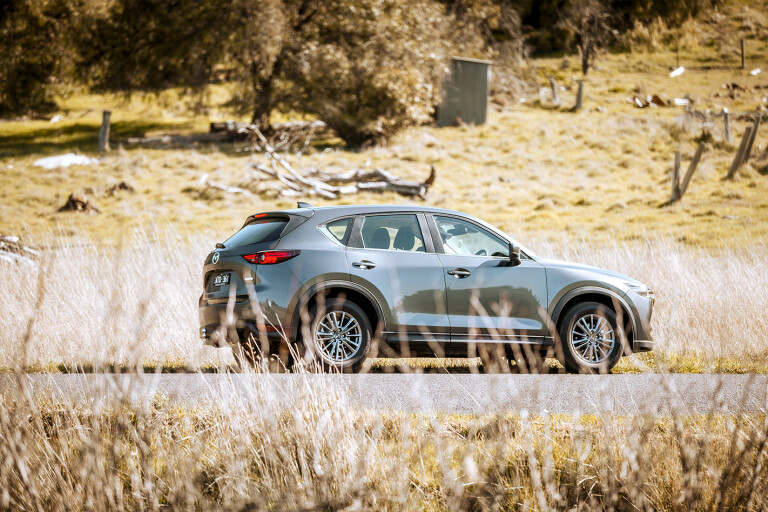
Away from the dragstrip, selecting Sport holds a selected ratio (and won’t upshift in manual mode), to spice things up, but the accompanying rev roar is annoying around the ’burbs – a persistent anomaly with the otherwise sweet-shifting six-speed torque-converter auto. Plus, the CX-5’s a whole litre thirstier than the VW. We eagerly await the compressed-ignition SkyActiv-X tech – or the coming turbo – to shake things up in the Hiroshima-mobile.
Still in Japan, the Forester feels altogether torquier right from the get-go, providing a decent amount of poke despite the CVT gearbox’s inherently elastic response. Paired with the heavily revamped atmo FB25, in ‘S’ sport mode there’s an appealing turbine-like induction sound that’s in keeping with the boxer’s progressive power delivery, while a total of seven ratio steps allow a simulated kickdown for an added sense of urge.
Ultimately, the numbers are only slightly better than what the Mazda managed. All that said, the newcomer’s performance story gels brilliantly, for the eager, effortless and lightweight Subaru seems to scoot along with an oiled slickness – and real-world fuel economy benefits – that was once the sole province of a VW Group powertrain. Upshot? Keep an eye on your speed.
Luckily, the faithful Forester’s brand-spanking chassis is more than up for a challenge. No SUV here seems as glued to the tarmac or as unruffled being hurried along, even if some body lean accompanies more extreme antics. In wildly wet and windy conditions, this thing is rock-solid, revealing an inherent insouciance. All that window glass helps inspire confidence, too.
For keen drivers, the well-weighted steering comes up short on real feel and feedback, electing instead to just get on with the job of prioritising secure and calm control. As this is an SUV and not a WRX, that’s probably okay. Especially as the plush ride, long a series strength, resides on a higher plane than the others, underpinning pleasingly pillowy progress yet still with outstanding dynamic poise. Butts will love this Subaru.
And, guess what? For all its lowered and stiffened suspension tuning and 19-inch rubber, the Ford shocked us by not transmitting a shocking ride. The ST-Line’s ability to firmly but effectively cushion really cruddy surfaces exposes an underlying chassis suppleness.

Such proficiency is more profound when factoring in the Escape’s life-affirming steering communication (in the company of other SUVs, anyway) and nuanced responses, connecting driver with machine for fast, fluent handling as well as taut cornering composure. This is far more an elevated-Focus than the wagon proportions purport. Only considerable road rumble from the quality Conti tyres takes away from the sophisticated bandwidth of capabilities on offer.
Equally up for a blast, the CX-5 confirms its reputation for B-road talent and enthusiasm and, in isolation, its mix of receptive, inclusive steering feel and pin-point handling can make a believer of even the most avid SUV-hater, especially as the powertrain seems to thrive on a caning. This thing eggs you on to push harder.
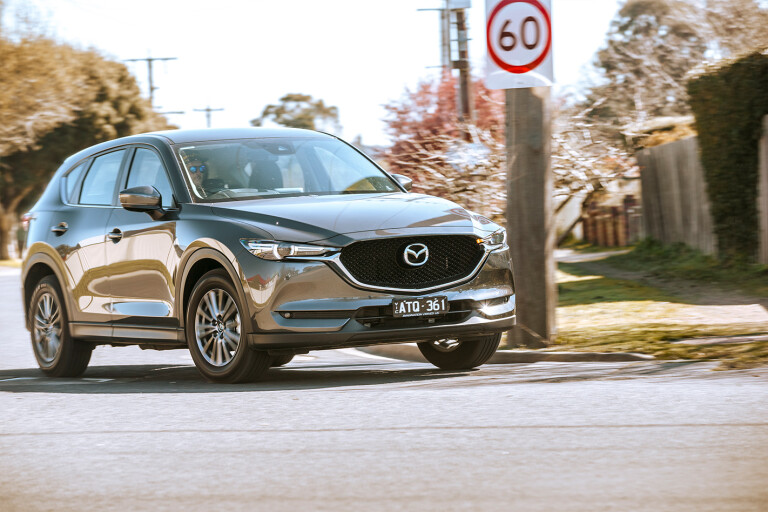
But do so, especially after a spell in the others, and the helm is too sharply geared at speed, resulting in a nervous and skittish feel. And the suspension, as mentioned earlier, never quite settles, either, transmitting road irregularities constantly.
Somewhere in between resides the Tiguan – excellent steering contact for utterly trustworthy two-way handling interaction, bracing roadholding skills and – on nice roads – that good old VW Teflon comfort. Plus, the harder you drive, the more the ingrained Golf DNA shines through. Impregnable fun to be savoured.
However, over rubbish roads, that lavish gloss can be chipped away one bump at a time, shifting away from the Comfortline billing to an extent that its hatch sibling never does. And while riding on balloon-like 17in tyres.
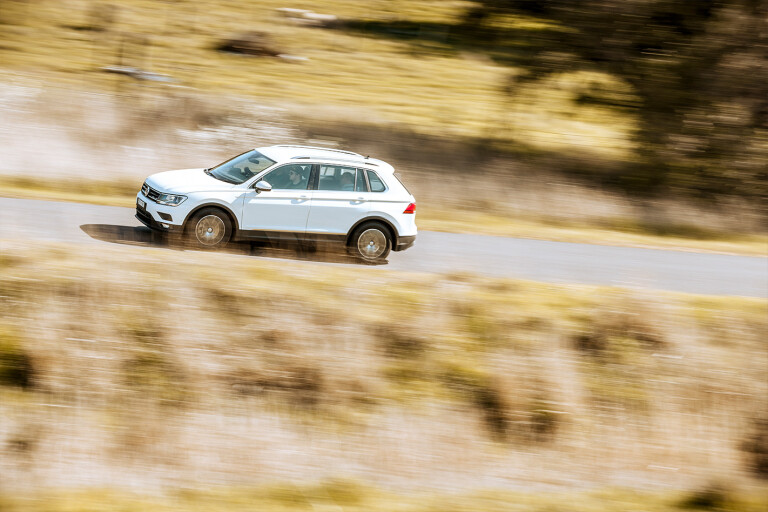
Ultimately, the Forester walks away with the win, representing a step forward for both Subaru’s evergreen model line and SUVs in this segment. The design is certainly divisive, but otherwise the Subaru is stunningly complete, with loads of character and very few vices.
Second and third is a closely run thing. With deep pockets, the Tiguan can be specified to drive, steer, handle and ride like a cut-price Audi, but without these worthwhile yet costly options, it feels inferior to a Golf. ‘Comfortline’, it seems, is a misnomer.
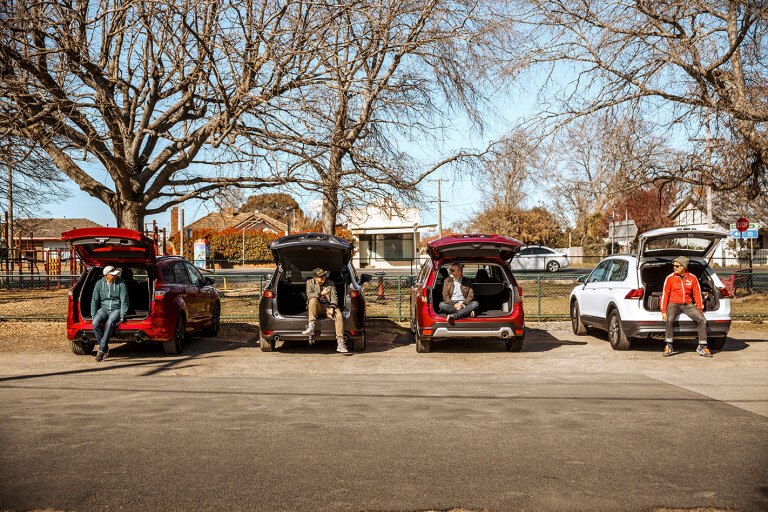
The CX-5, meanwhile, offers fine value and feels special on many unanticipated levels, including the area of cabin design and presentation. Yet, like the German, the Touring is patchy in other parts – namely in its refinement, outright performance and standard driver-assist spec.
Finally, our appropriately wild, wildcard, the Escape. Sharply priced, smartly packaged and sophisticated dynamically, it’s a cool yet warm-under-the-collar outcast that deserves acceptance, even if you’ll pay at the bowser. Be prepared to be charmed by this slightly crusty old dog. Fourth place here is no disgrace. Long live the driver-oriented engineering ethos at Ford, and the brand’s ability to turn out a cracking steer.
So, it’s the fulsome Forester that elevates itself above all with sheer effortlessness. It simply rises above the trees of normal SUVs.

COMMENTS